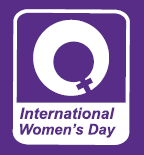Gender differentials in health [Chapter 10 of Disease
Control Priorities in Developing Countries, 2nd ed., DCPP, 2006]
Water, gender and citizenship: Involving men and women in
the management of water and sanitation
services [WSP, 2007]
Water, Sanitation & Gender [World Bank Gender and
Development Briefing Note, 2007]
Gender, Water and Sanitation: A Policy Brief [UN Water,
2006]
Why are there so few public toilets for women? [Times Online, 2008]
►Dignity and
the decent facility [New Internationalist,
2008] – “Sanitary
engineers regard a toilet as a health aid, but women paint a very different
picture.”
Breaking the
silence on menstrual hygiene in Bangladesh [IRC Source, 2008] − design latrines to accommodate
women’s needs.
Gender-sensitive
toilet design meets cultural needs of girls and women in north-east Nigeria [IRC Source News, 2008]
Another School
Barrier for African Girls: No Toilet [New
York Times, 2005]
Gender and Water − Securing Water for Improved Rural Livelihoods:
The Multiple-uses System Approach [IFAD, 2007]
Mainstreaming gender in integrated water resources
management strategies and plans: practical steps for practitioners [GWP, 2006]
Women as
Agents of Change [IFAD, 2003]
Easier to say, harder to do – gender, equity and water [BCID, 2003]
Women and Children: The Double Dividend of Gender Equality [UNICEF SOWC 2007]
►
Gender equality quiz
Women and
community water supply programmes: An analysis from a socio-cultural
perspective [see pdf pages 33−51, Water Resources Journal, UNESCAP,
2005]
Gender equality – at the heart of development [DFID, 2007]
Effective Gender Mainstreaming in Water Management for Sustainable Livelihoods:
From Guidelines to Practice [Gender and Water Alliance, 2006]
Taking Action: Achieving Gender Equality and Empowering Women [UN Millennium Project Task Force on Education and Gender Equality, 2005]
Infrastructure for All [WEDC, 2007 - enter title in box, click on ‘Submit’ and follow
instructions to get the pdf]
Gender equality: Fact sheet [DFID, 2006]
Self-service − in India’s traditionally patriarchal
society, women’s self-help groups are driving a silent revolution [DFID Developments
#38, 2007]
Women and Water [UN, 2005]
Women and Water [ADB, 2003]
For Her It's the Big Issue: Putting Women at the Centre of Water
Supply, Sanitation & Hygiene
[WSSCC, 2006]
State of world population 2005: The promise of equality,
gender equity, reproductive health and the Millennium development goals [United
Nations Populations Fund, 2005] University of Leeds Library catalogue entry.
Women2000 and
Beyond: Women and Water [UN DAW, 2005]
Untapped
Connections: Gender, Water and Poverty [WEDO, 2003]
A Gender Perspective on Water Resources and Sanitation [UN DESA CSD, 2004]
Women and Water: How is Gender Policy Working on the Ground?
[Water Research Commission,
South Africa, 2004]
Gender Guidelines: Water Supply and Sanitation [AusAID,
2005]
A Gender and Development Approach to Water, Sanitation and Hygiene
Programmes
[WaterAid, 1999]
Gender and Water [IRC Thematic Overview Paper, 2004]
Mainstreaming Gender in Water Management [UNDP, 2003]
Women, water management, and health [EID, 2004]
Ten key points to check for gender equity
[UNICEF]
Integrating Gender
Responsiveness in Environmental Planning and Management [UN Habitat, 2000]
Towards Woman-friendly Cities [Habitat Debate, 2002]
Women in Cities [Habitat Debate, 2005]
Fourth World Conference on Women [held in Beijing, 1995]
Abstracts on
Women, Water and Sanitation 1991−98 [IRC, 1998]
Women and Sanitation [UN-Habitat, 2007]
Women and the Transport of Water [IT
Publications, 1986]
Economic efficiency
and supply response of women as farm managers: comparative evidence from
Western Kenya [World Development,
2008]
Poverty-Environment:
Gender Linkages [OECD, 2001]
Unheard Voices: Some Voices of India’s Underprivileged Women [UN-Habitat, 2007]
− Mumbai has a population of 15 million. More that
half of this population live in slums. Only some of the slums have been
legalized and provided with limited piped water supply and a few public
latrines. These are grossly inadequate for the entire slum population. In such
a scenario, the major burden of searching for water and sanitation facilities
is borne by women.
Women and Development [Copenhagen Consensus
Center, 2008]
Climate change
Coping with climate change: What works for women? [Oxfam,
2008]
"Women are the most wasted
resource in the world" − listen here (90 minutes,
22 MB) or read here [RSA/Economist Debate, January 2007]
WaterAid
video: Women: Agents of change
WaterAid audio: Women in Nigeria − the importance of including women in the
decision-making process when carrying out water and sanitation projects.
Video: Women’s Voices [GWA, 2005] – this film shows the experience of a community in establishing
simplified sewerage systems with a gender focus in periurban areas of Cali,
Colombia.
Maps [worldmapper.org]
Girls not in primary education
Girls not in secondary education
Women not in tertiary education
Illiterate young women
Illiterate women
Websites
UN Women – the United Nations Entity for Gender Equality and the
Empowerment of Women, set up in July 2010. It will subsume: United Nations Development Fund for Women (UNIFEM)
Women and Water;
UN Commission on the Status of Women; and UN Division for the Advancement of Women
Gender and Water
Alliance
Gender Equality (Oxfam)
Gender Equality & the Millennium Development Goals
Women's Environment & Development
Organization
 International Women's Day
International Women's Day
No comment necessary!